| Case Name |
Fire due to heat accumulation from oxidation of stuck materials on the wall of a blown asphalt tank of a refinery |
| Pictograph |

|
| Date |
October 23, 1990 |
| Place |
Kurashiki, Okayama, Japan |
| Location |
Refinery |
| Overview |
While blown asphalt was being loaded into a lorry from a blown asphalt storage tank, the domed roof of the tank welled and it ruptured. Flames spouted and the asphalt flowed out. Light fractions had possibly attached to the upper side of the tank and caused a fire due to heat accumulation from oxidation. |
| Incident |
An explosion occurred while blown asphalt was being transferred to a lorry from a blown asphalt storage tank, and its roof was destroyed at the same time. Insulating materials were scattered and black smoke spouted out. The asphalt flowed from cracks in the outer part of the tank bottom plate, and it then spread. Refer to Fig2. |
| Processing |
Storage |
| Substance |
Asphalt |
| Type of Accident |
Rupture, fire, leakage |
| Sequence |
The blown asphalt was manufactured and received till October 20th, 1990, three days before the fire.
On October 23rd, the circulation operation of the blown asphalt was done through the shipping line using a pump as usual.
About 14:44, loading into the lorry started. The domed roof started to swell at the north side.
About 14:46, after the whole roof had swelled, it ruptured. Flames spouted out, the roof fell down inside the tank and the upper part of the sidewall at the south side was bent down inside. The asphalt flowed out from a crack in the outer part of the tank bottom and spread. |
| Cause |
The storage temperature of blown asphalt is approx. 220 °C, which is 50 °C higher than normal asphalt. Therefore, the blown asphalt was likely to attach to the inside wall of the tank gradually, accumulated heat, and finally ignited. The tank was not sealed with nitrogen. |
| Response |
Shutting the valve of heating pipe of the tank where the fire occurred. Shutting down the asphalt manufacturing plant. Cooling water was sprayed to extinguish fire as the steam pipe was bent. |
| Countermeasures |
Periodic measurement of combustible gas concentration should be done.
Conditions inside the ceiling plate should be monitored by measuring the ceiling plate temperature.
The plant management standards should be reviewed.
Storage temperature should be lowered for preventing evaporation of light fractions.
The standard needs to be reviewed and employee education should be reinforced. |
| Knowledge Comment |
Storage temperature of blown asphalt is 50-60 °C higher than normal asphalt and tends to release light fractions. As a preventive measure, sealing with nitrogen is necessary. Material attaching to the upper part of the tank might be unavoidable. |
| Background |
The storage temperature of the tank was high and the tank was not sealed with nitrogen. It should have been possible to predict accumulation of light fractions of asphalt, and attachment of the gas phase material in the tank to the inside wall of the tank. According to overseas literature, when attachments to the top plate reach 190 °C, they can spontaneously ignite. This was the first fire of a blown asphalt tank that occurred in Japan. The maintenance might be insufficient, overlooking the hazards of material characteristics. |
| Incidental Discussion |
Blown asphalt is manufactured by a process of polycondensation with compressed air. That is why you can see the bubbling foamy surface of blown asphalt, explained an engineer. This fact might affect the material sticking to the vapor layer of a blown asphalt tank. |
| Reason for Adding to DB |
Unexpected spontaneous combustion of asphalt |
| Scenario |
| Primary Scenario
|
Poor Value Perception, Poor Safety Awareness, Inadequate Risk Recognition, Insufficient Analysis or Research, Insufficient Prior Research, Insufficient Gathering of External Information, Planning and Design, Poor Planning, Poor Design, Bad Event, Chemical Phenomenon, Oxidation/Heat Accumulation, Failure, Large-Scale Damage, Rapture, Secondary Damage, External Damage, Fire/Leakage, Loss to Organization, Economic Loss, Direct Monetary Damage 15 million yen
|
|
| Sources |
Japan Society for Safety Engineering edit. Kurashiki City Mizushima fire department, Fire accident in asphalt tank of M Petroleum M refinery, Examples of Fire and Explosion. pp.119-124(2002)
The high pressure gas safety institute of Japan, High-pressure gas protection overview, pp.214-216, 217(1991)
The high pressure gas safety institute of Japan, "Storage tank, fire in blown asphalt tank," Examples of accidents in petroleum refinery and petrochemical units. pp.84-86(1995)
M. Tamura, M. Wakakura, Explosion and fire in an asphalt tank, Reaction danger.- Accident case and analysis -p.117(1995)
|
| Physical Damage |
An asphalt tank, a tank roof, 504 kL of blown asphalt burned, the outflow of blown asphalt was estimated to be about 320 tons. |
| Financial Cost |
¥ 15 million (Reaction danger - Accident case and analysis - ) |
| Multimedia Files |
Fig2.Photo of Tank in burning
|
| Notes |
Fire due to oxidized heat accumulation |
| Field |
Chemicals and Plants
|
| Author |
WADA, Yuji (National Institute of Advanced Industrial Science and Technology)
TAMURA, Masamitsu (Center for Risk Management and Safety Sciences, Yokohama National University)
|
|